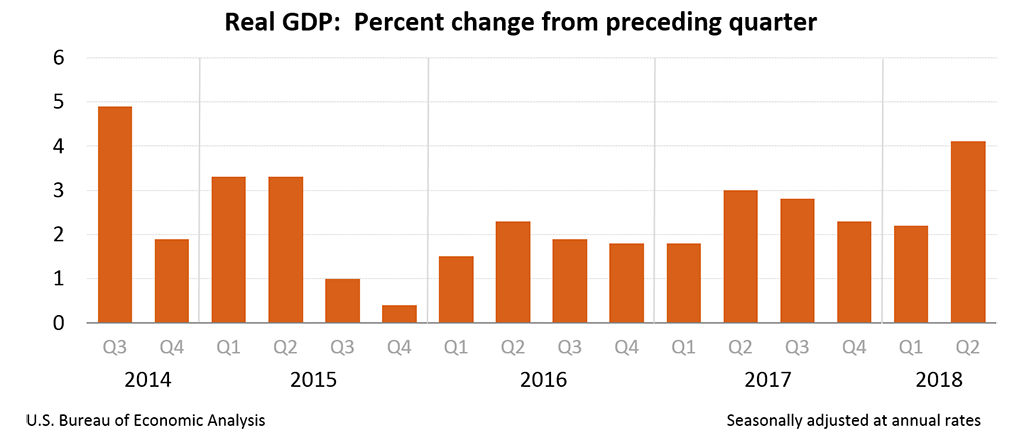The American economy grew at its fastest quarterly pace in four years between April and June, according to data (.pdf) released on Friday from the U.S. Bureau of Economic Advisors (BEA). According to the “advance estimate” of second quarter gross domestic product (GDP) growth, the economy expanded at a 4.1 percent clip – nearly twice as fast as it did during the first quarter of the year (revised to 2.2 percent growth).
That’s the best print since the third quarter of 2014 – and was roughly in line with analysts’ expectations.
Annual growth is currently clocking in at 2.8 percent – its highest level since the second quarter of 2015.
Take a look …
(Click to view)
(Via: BEA)
The BEA will issue a second estimate on August 29 and a final estimate for the quarter toward the end of September.
Supporters of U.S. president Donald Trump praised the data point …
“Today’s announcement that the second quarter GDP grew by 4.1 percent annualized is further proof that the Trump economic policies of tax cuts, deregulation and better trade deals are beginning to take hold,” said Rick Manning of Americans for Limited Government (GetLiberty.org). “While there is still work to be done to reach a three percent annual growth rate for 2018, the accelerating economy demonstrates the kind of strength needed to meet or beat President Trump’s three percent GDP growth promise.”
Of course Manning added that the real good news was an uptick in the number of working age adults aged 16-64 who were now participating in the labor force.
“This isn’t about statistics, this about people’s lives and people’s hopes and dreams coming true,” he said. “That’s what truly matters.”
We agree …
[timed-content-server show=’2018-Jan-17 00:00:00′ hide=’2018-Oct-22 00:00:00′](SPONSORED CONTENT – STORY CONTINUES BELOW)
Here’s the question: Is the “Trump surge” sustainable?
Economists are pessimistic …
“Temporary support from one-off gains coupled with trends of waning momentum, not to mention outright weakness in the housing market, calls into question the sustainability of above-trend topline growth looking out to the second half of the year,” noted Lindsey Piegza, chief economist for Stifel Fixed Income.
Stifel specifically singled out the housing market as “a potential red flag to future growth.”
Also, as we have previously pointed out, Trump’s failure to rein in spending in Washington, D.C. (here and here) – and his failure to insist upon a larger tax cut that targeted more relief to middle income earners – loom large on the horizon.
Mark these words: Robust growth will never sustain itself without a fundamental realignment of taxation and spending in our nation’s capital.
Don’t believe us?
In this case, data doesn’t lie: The ongoing era of obscenely big government has not been good for American prosperity. At all.
Former U.S. president Barack Obama – the biggest big government president of all time – was the first U.S. chief executive since Herbert Hoover not to preside over at least one year in which the economy expanded at a rate of three percent or higher.
America’s economy hasn’t expanded at a three percent rate in more than a dozen years. It hasn’t eclipsed the four percent threshold since 2000 – former U.S. president Bill Clinton’s final year in office. By contrast, growth exceeded five percent in twelve out of thirty years from 1950-1980. And it exceeded four percent in seventeen out of those thirty years.
***
WANNA SOUND OFF?
Got something you’d like to say in response to one of our stories? Please feel free to submit your own guest column or letter to the editor via-email HERE. Got a tip for us? CLICK HERE. Got a technical question or a glitch to report? CLICK HERE. Want to support what we’re doing? SUBSCRIBE HERE.
Banner: Getty

